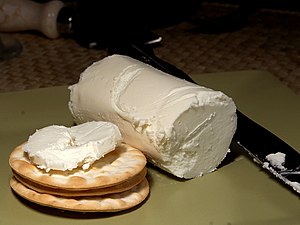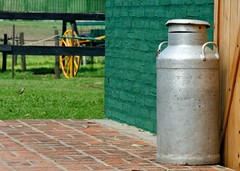Cheese Making 101
 |
| English: Goat's milk cheese (Photo credit: Wikipedia) |
Cheese is a
nice subject to begin the week with. I cannot imagine a world without cheese.
There are so many types and flavors that you can find a taste to suit almost
any one.
Cheese was really
developed as a way to store excess milk and make it where people who are
lactose intolerant can digest and benefit from the nutrition available in milk.
 |
| Milk (Photo credit: @Doug88888) |
Lactose
Intolerants is actually more common than most people realize and depends mostly
on our heritage. In the majority of mammals the body naturally stops producing
the enzymes necessary to break down the Lactose (sugars) in milk when it is
time to stop nursing. People are mammals
by the way. As people progressed from the hunter gatherer stage into more
advanced types of society we began to heard animals and plant crops. This lead
to many changes in our diet and we developed the ability to keep nursing (drinking
milk) beyond the time we would have normally stopped.
If your ancestors
came from one of these herding cultures you have a good chance of being lactose
tolerant, if they didn’t, well you’re out of luck. Lactose intolerance can range
from sever stomach upset to mild flagellants (gas) depending on the extent of
your intolerants. Many people are lactose intolerant and never even relies it
the symptoms are so mild.
If you are
one of the unlucky ones among us and your body will not tolerate lactose, have
no fear cheese is the answer. I was explaining this to friend and he tried to
call me on it. He said I have tried cheeses and all I got was a stomach ache. I
asked him what kind of cheeses he tried and of course his answer was whatever
my wife bought at ______. I asked was it wrapped in plastic or foil and he
answered of course. I knew the answers to my questions before I asked them. I
have had these conversations before. He was shocked and most people are shocked
when I tell them “you still haven’t tried cheese then.
The making
of cheese is much simpler than most people realize. The basics are you
introduce enzymes into milk; they break down the lactose and leave you with an
easily digestible product that is both delicious and nutritious. I will walk you through the process here for
making a simple cream cheese. I use this recipe and then add seasonings to the finished
product just to create different taste. If you don’t like spicy foods, don’t
worry, just spread this simple cheese on toast and enjoy.
For this
project you’re going to need:
1 gallon of whole milk
(Not the super pasteurized but any other will
do)
A colander
A large cloth
(Cheese cloth is best but any cotton
will do, I use pillow cases)
A thermometer
A large stainless steel pot
Enzyme culture
(Available on line or at many gourmet
shops, different cultures make different cheeses)
Pinch of salt
Pour your
milk into your stainless steel pan and place over a low heat, stirring occasionally.
Don’t heat too quickly or you will scald the milk. Using your thermometer bring
the milk to 85 deg. Fahrenheit (29 deg. Celsius); stir in your enzymes; remove
from heat and cover. Walk away and leave sitting on your counter.
 |
| Pectic Enzyme (Photo credit: John Holzer) |
I recommend
doing this in the late afternoon. Eat supper, read, watch television and have a
good night’s sleep, the enzymes are doing the work not you.
Arise about
15 minutes early in the morning; go to the kitchen and remove the lid from your
pot. What you are going to find is a thick skim on top, this is your curd. Line
your colander with your cloth and spoon this curd into it. Let the curd drain
for a few minutes; remove it to bowl and mix in a little salt. You have fresh
Cream Cheese for your morning toast. Enjoy



No comments:
Post a Comment
Please let us know how we are doing. Comments and suggestions are greatly appreciated.